Workforce Investment Agency Division
____________ WIA ____________

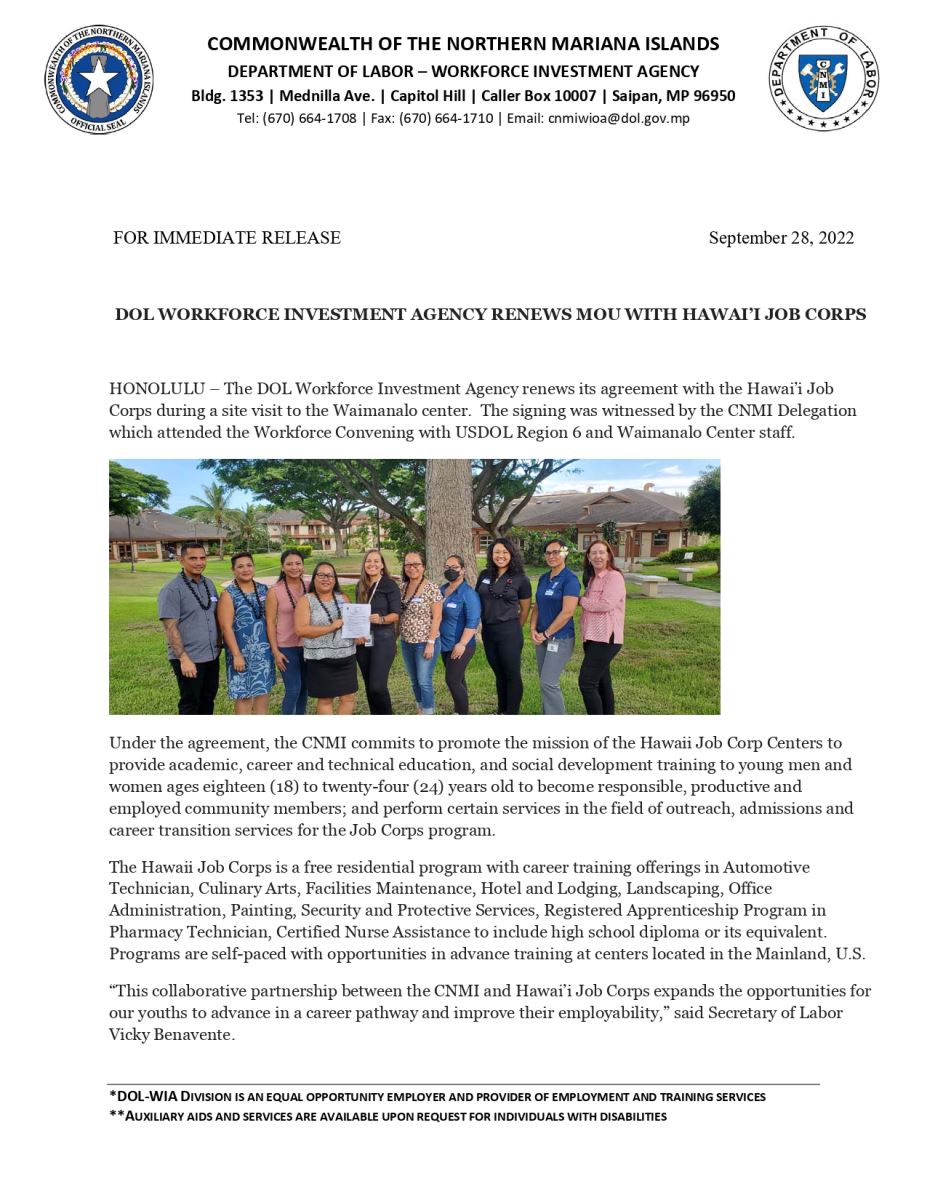


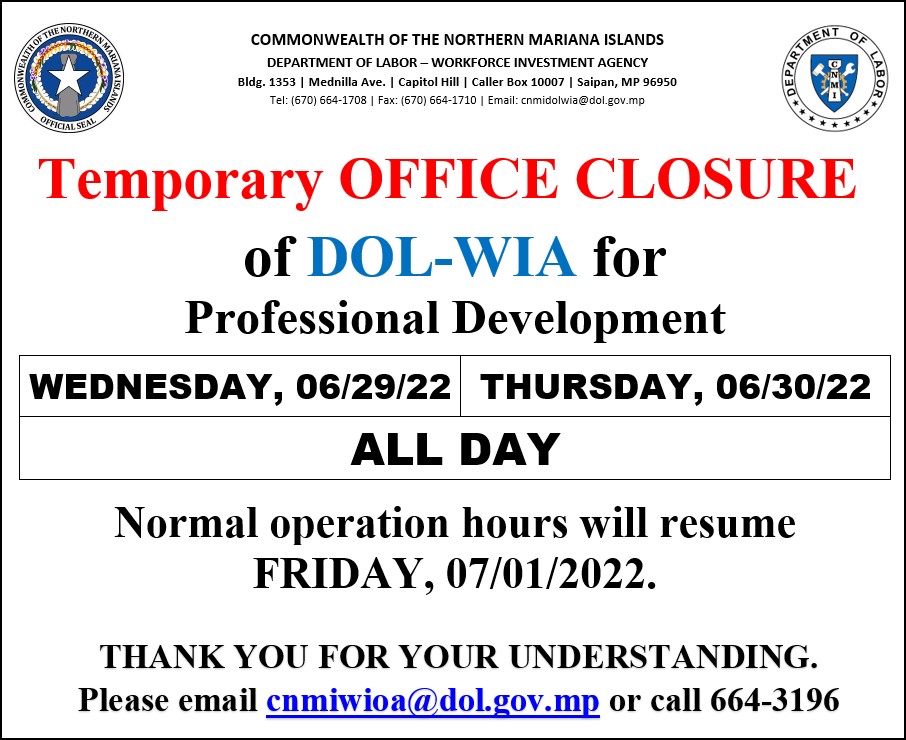

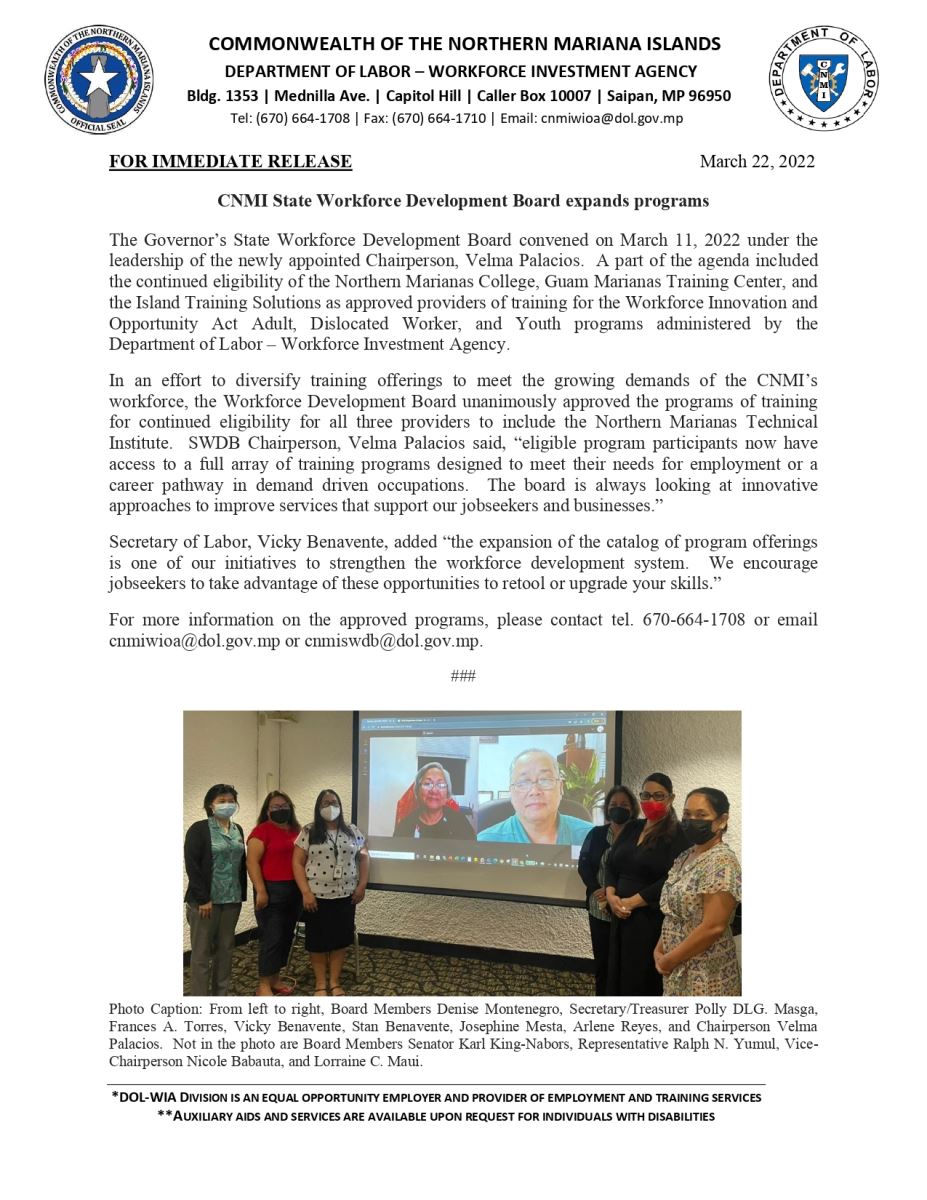
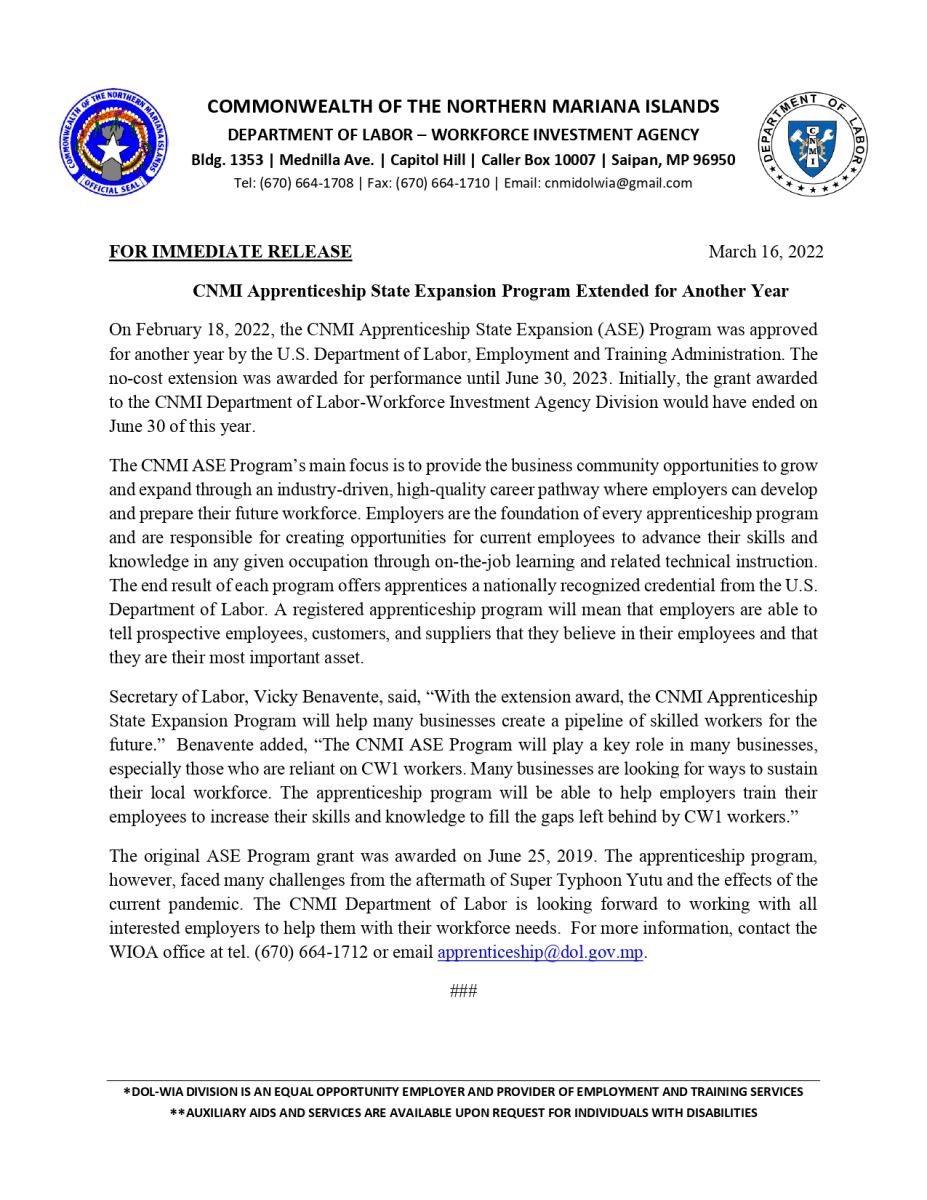
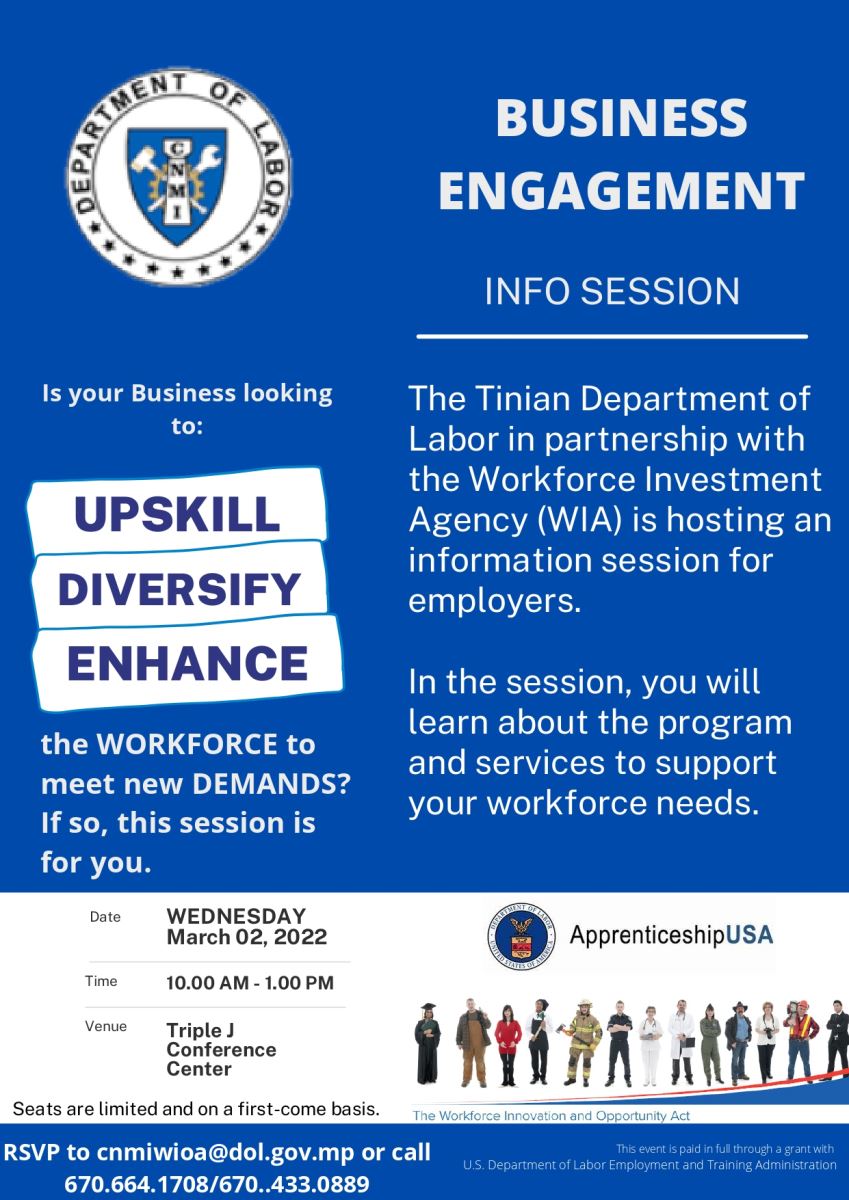
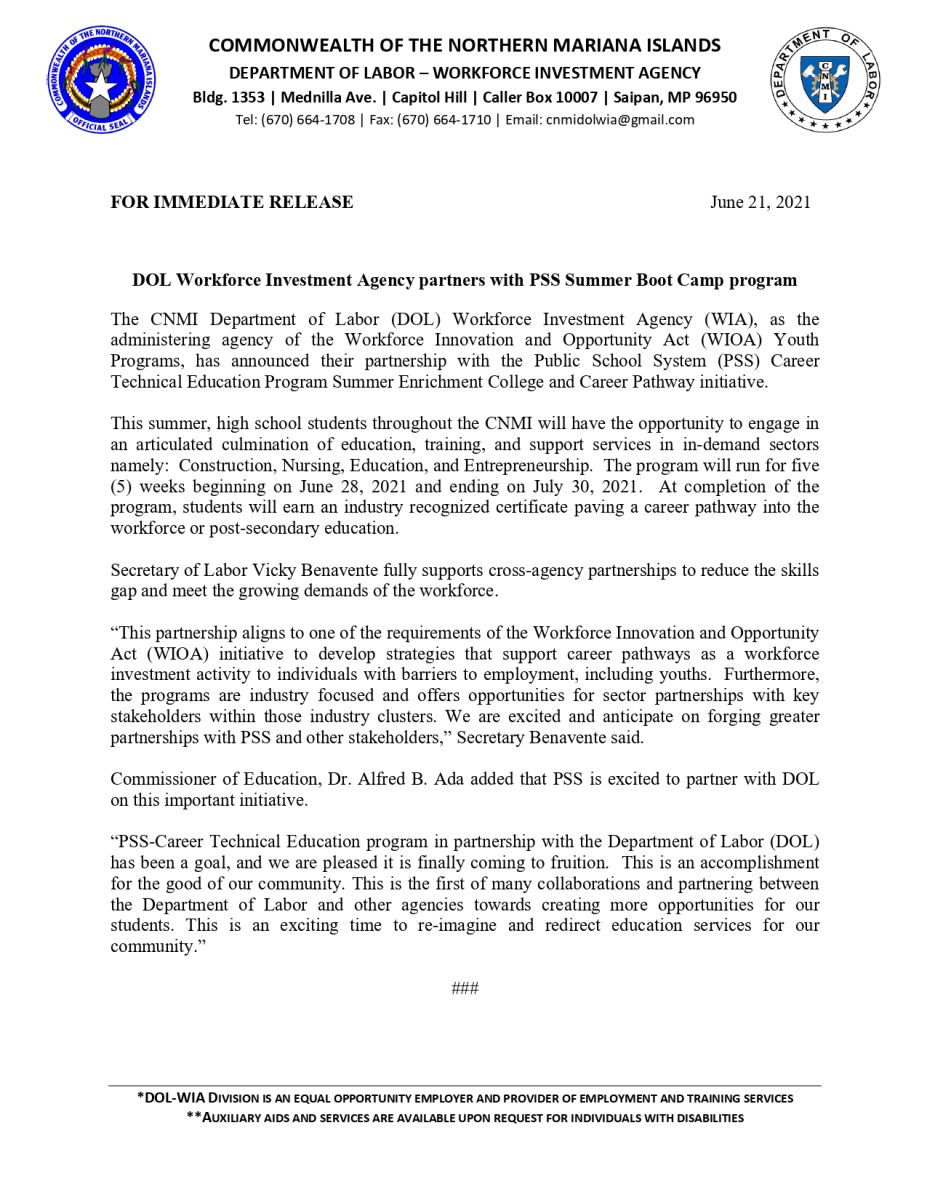
?
STATE WORKFORCE DEVELOPMENT BOARD
P.O. Box 10007 | Saipan, MP 96950 | Phone: (670) 664-1712 | Email: cnmiswdb@dol.gov.mp
Vision: “To integrate a seamless workforce development system that meets the needs of employers, job-seekers, workers, and youths in order to supply quality employees for the dynamic economy of the CNMI.”
PUBLIC NOTICE
The CNMI’s State Workforce Development Board in collaboration with the Workforce Innovation and Opportunity Act (WIOA) core program partners (DOL Workforce Investment Agency, NMC Adult Education State Office, and Office of Vocational Rehabilitation) will be modifying portions of the CNMI’s Unified State Plan for Program Years 2022-2023.
Proposed modifications to the plan include:
- A description of current economic, workforce, and workforce development activities impact analyses of the COVID-19 pandemic.
- State strategic goals to achieve the vision of the CNMI “To integrate a seamless workforce development system that meets the needs of employers, job-seekers, workers, and youths in order to supply quality employees for the dynamic economy of the CNMI.”
- Performance goals for Program Year 2022 and 2023.
- Update the State Operating Systems for the SWDB and the core programs.
The public is invited to provide input or comments on the proposed changes during a thirty (30) day public comment period beginning February 10, 2022 and ending on March 10, 2022.
There will be virtual and in-person public forums to discuss the modifications on Saipan, Rota, and Tinian that will be announced at a later date.
A copy of the CNMI 2020-2023 Unified State Plan may be found on www.marianaslabor.net.
/resources/files/divisions/WIA/Northern_Marianas_PYs_2020-2023(1).pdf
Please submit all comments in writing to cnmiswdb@dol.gov.mp, lorraine.maui@marianas.edu, or arlene@ovrgov.net with the subject line CNMI State Plan 2022. The deadline for comment submission is Thursday, March 10, 2022 at 4:30pm.
/s/ Velma Palacios, Chairperson Date: February 10, 2022
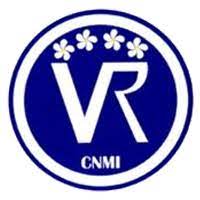
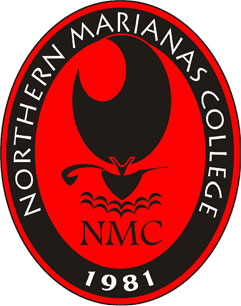

|
II.b.(2)[A][B] State Strategic Goals |
|
|
PY2020-2021 Goals |
Proposed Goals for PY 2022-2023 |
|
Goal 1: Develop and Implement a Youth Leadership Training system/program to have youth build competitive attributes of a leader and gain confidence of in their abilities and career choices. |
Strengthen the collaboration of the workforce development system for the expansion of a comprehensive, integrated, effective, and streamlined service delivery system.
|
|
Goal 2: Develop and Implement Workforce Development Leadership Training system/program to have adults, dislocated workers, job-seekers, and incumbent employees build competitive attributes of a leader and gain confidence of in their abilities and career choices. |
Enhance Business Service strategies to increase strategic partnerships and engagement to develop customized services that aligns with the present-day economy across programs of the workforce development system.
|
|
Goal 3: Promote and support participant’s efforts to obtain necessary workforce experiences, workforce credentials, skill development and training, and/or career or college readiness in order to increase the number of competitive participants who are ready to enter employment or gain upward mobility and livable wages in the careers of their choice.
|
Integrate an innovative customer-centered service delivery system focused on the customer’s job-driven occupational and training needs that includes enhanced supportive services to address barriers that may impede participation.
|
|
Goal 4: Align, coordinate, and integrate the local and state workforce development systems in order to match workforce skills needs of employers those participants who have the marketable skills and attributes needed to be competitive choice of employers.
|
Increase the skills of jobseekers for high-quality jobs and careers in demand-driven industries that align with the workforce needs of employers that lead to employment, reemployment, and retention. |
|
II.b.(3) Performance Goals Titles I, II, and IV |
|||||
|
Program |
Performance Measure |
Program Year 2020-2021 |
Program Year 2022 |
Program Year 2023 |
|
|
Negotiated Level |
Proposed Level |
Proposed Level |
|||
|
Title I Youth |
Education, Training, or Employment (2nd Quarter after Exit) |
50.0% |
50.0% |
50.0% |
|
|
Title I Adult & Dislocated Worker |
Employment (2nd Quarter after Exit) |
50.0% |
50.0% |
50.0% |
|
|
Title II Adult Basic Education |
2020 |
2021 |
57.0% |
58.0% |
|
|
55.0% |
57.0% |
||||
|
Title IV Office of Vocational Rehabilitation |
Baseline |
50.0% |
50.0% |
||
|
Title I Youth |
Education, Training, or Employment (4th Quarter after Exit) |
50.0% |
50.0% |
50.0% |
|
|
Title I Adult & Dislocated Worker |
Employment (4th Quarter after Exit) |
50.0% |
50.0% |
50.0% |
|
|
Title II Adult Basic Education |
2020 |
2021 |
60.0% |
61.0% |
|
|
58.0% |
60.0% |
||||
|
Title IV Office of Vocational Rehabilitation |
Baseline |
Baseline |
Baseline |
||
|
Title I Adult & Dislocated Worker |
Median Earnings (2nd Quarter after Exit) |
$3,200 |
$3,200 |
$3,200 |
|
|
Title I Youth |
$3,000 |
$3,000 |
$3,000
|
||
|
Title II Adult Basic Education |
$4,153 |
$4,153 |
$4,153 |
||
|
Title IV Office of Vocational Rehabilitation |
Baseline |
Baseline |
Baseline |
||
|
Title I Adult & Dislocated Worker |
Credential Attainment Rate |
66.5% |
66.5% |
66.5% |
|
|
Title I Youth |
66.0% |
66.0% |
66.0%
|
||
|
Title II Adult Basic Education |
2020 |
2021 |
81.0% |
82.0% |
|
|
89.0% |
81.0% |
||||
|
Title IV Office of Vocational Rehabilitation |
Baseline |
Baseline |
Baseline |
||
|
Title I Adult & Dislocated Worker |
Measurable Skill Gains |
50.0% |
50.0% |
50.0% |
|
|
Title I Youth |
50.0% |
50.0% |
50.0%
|
||
|
Title II Adult Basic Education |
45.0% |
50.0% |
51.0% |
||
|
Title IV Office of Vocational Rehabilitation |
Baseline |
Baseline |
Baseline |
||
?